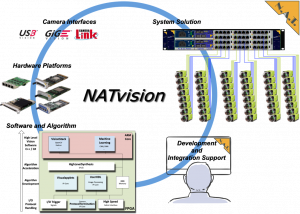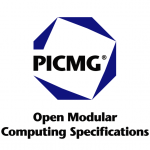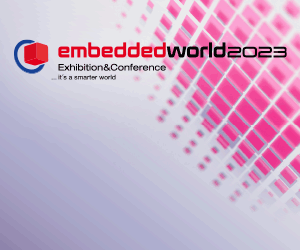
Embedded World 2024 (Apr 9-11)
N.A.T. presents FPGA-based vision platform for real-time imaging data analytics of multiple high-end cameras at stand 1-211 in hall 1
Bonn/Germany, 20 March 2024 - At Embedded World 2024, N.A.T. is presenting NATvision, its new real-time capable, FPGA-based vision platform for high-resolution, high-end cameras based on the MicroTCA standard (Embedded World). NATvision is the world's first platform of its kind that fully utilizes AMD's (formerly Xilinx) ZYNQ UltraScale+ MPSoC FPGA technology for the processing and analysis of imaging data streams from high-performance video cameras.
NATvision enables developers and system integrators to process imaging data streams from multiple high-resolution, high-end cameras in real time on a single consolidated platform. NATvision stands out from conventional PC-based vision platforms by utilizing faster and more energy-efficient FPGA technology, which can be modularly adapted to the individual processing tasks and a wide variety of transmission protocols as required. Thanks to the scalability of NATvision, up to twelve FPGA cards per system can be combined in a single system. The system is suitable for connecting cameras with a data throughput of up to 100 GbE.

Wide range of applications
NATvision is based on the open MicroTCA standard, which achieves a very high degree of modularity and at the same time allows enormous amounts of data to be transferred flexibly between all of the system's plug-in cards via its high-speed backplane. Thanks to its modularity, every NATvision system can be supplemented with additional processors and AI accelerators. NATvision naturally supports time synchronization using IEEE1588 to ensure high-precision time synchronization of all connected cameras. This makes NATvision the ideal solution for image processing with high frame rates and high image resolutions in real time.
NATvision enables the use of high-resolution, high-end cameras for inspection, quality control and monitoring across the entire value chain of industrial companies - from development and production to packaging, as well as in safety and security applications. Vertical markets can be found in industrial production (e.g. analyzing off-rollable meterage, printed items, and bulk materials as well as semiconductors and electronic assemblies), aerospace and automotive testing (e.g. material stress tests, crash tests, airbag dynamics, aerodynamics, combustion processes in engines, thermal measurement). Other applications include accident prevention systems in intelligent transport systems (e.g. railway technology), medical imaging (e.g. X-ray) and science/research (physics, chemistry, biology/biomechanics).
The technology in detail
The FPGA-based NATvision vision system from N.A.T., which is being presented for the first time at Embedded World, can be equipped with one to twelve FPGA cards to suit specific requirements and applications. The performance of the AMD ZYNQ UltraScale+ MPSoC processors can be scaled from 103,000 to 1.143 million logic cells, depending on requirements. The design of the in-house GigEVision firmware package for the FPGA cards is also modular, so that other camera interfaces such as CoaXPress can be easily integrated instead of GigEVision. The sample applications supplied with NATvision and the GenICam-compatible SDK enable users to quickly commission the system and integrate it into their own software routines. N.A.T. is currently working with a partner to add AI functionality to the system. The system chassis comes from partner nVent, which is also presenting the demo system at its Embedded World stand 211 in hall 1.
Live demo
The performance of the new real-time FPGA-based NATvision platform in high-speed/high-res vision applications will be demonstrated using a live demo that captures and visualizes the trajectory of a ball in real time. NATvision enables calculated trajectory predictions to be made, on the basis of which corresponding trigger signals can be initiated. Motion control systems can use such calculations to precisely identify goods that are recognized as faulty, e.g. to exclude them from the further production process at the appropriate point using a generated trigger.As part of the live demo, the image data is recorded with a 4K Ultra HD GigEVision camera with a resolution of 3,840 x 2,160 pixels at a frame rate of up to 180 frames/sec. Digital video data streams of up to 35 Gbit/s are transmitted and processed in the FPGA using N.A.T.'s own GigEVision firmware package. These data are then available for further FPGA-based processing as an AXI stream. Finally, the video data is written to the RAM of the FPGA-integrated ARM cores – which support Linux – via DMA. From there, data can be transferred to external nodes at up to 100Gbps via the system uplinks, for example. GPUs and AI accelerators can also be integrated as additional cards. Currently, each FPGA card can receive and process up to 40Gb/s of image data from up to four cameras. This value will increase to 100Gb/s per card in future. The measured processing latency in the FPGA is less than 500ns, while the processing speed is deterministic in every configuration.
Camera manufacturers, inspection system developers and system integrators can find more information about NATvision from N.A.T. and the service offering at https://nateurope.com/solution/natvision/
MicroTCA.0 Revision 3 released
Latest MicroTCA.0 Revision 3 adds high-bandwidth interfaces such as 100 GbE and PCIe Gen 5 with increased TDP to prepare the specification for demanding next-generation edge and server workloads and applications
WAKEFIELD, MA. PICMG, a leading consortium for the development of open embedded computing specifications, has ratified Revision 3.0 of the MicroTCA.0 (µTCA.0) specification. This new release addresses urgent bandwidth requirements by defining 100 GbE and PCIe Gen 5 fabrics that improve system performance by 4x while also expanding platform thermal design power (TDP), enabling the use of higher performance processors. Users can now select from a range of specification-compliant building blocks and solutions that allow for more power per slot for higher transfer rates within µTCA chassis and to external systems and server clusters. It also lays the foundation for building next-generation MicroTCA proofs of concept.
Revision 3 of MTCA.0 addresses the current and future demands of applications such as machine vision, AI, defense, research, instrumentation, wireless communication, and emerging applications like quantum computing. “Revision 3 of MTCA.0 addresses urgent requirements and thus enables companies to now provide specification-compliant solutions rather than proprietary or custom approaches,” says Heiko Korte of NAT Europe and lead of PICMG’s MicroTCA Technical Working Group. “The fact that so many MicroTCA ecosystem suppliers have joined the working group shows the importance of the changes and also underlines the strong interest to make these part of an open specification.
“The broad spectrum of participants also ensured that every single agenda item got reviewed from different angles and properly discussed,” he adds.
MicroTCA.0 Revision 3.0-compliant solutions will be available shortly, including chassis, MicroTCA Carrier Hub (MCH), Advanced Mezzanine Card (AMC), Rear Transition Module (RTM), and power modules (PM) products from VadaTech, NAT, AIES Sp z o.o., nVent SCHROFF, and others. The commitment of existing vendors to continuing the development of µTCA products is joined by increased interest from players in emerging fields like quantum computing, projecting a healthy lifecycle for the open computing specification for years to come.
“VadaTech is proud to have been part of the development and ratification of revision 3 of the uTCA specification,” says Alex Malcom, Managing Director of VadaTech Ltd. “Its release secures the continued adoption of the standard by commercial, scientific and defense organizations around the world.”
The MicroTCA.0 Revision 3.0 specification can be accessed at www.picmg.org/product/micro-telecommunications-computing-architecture-base-specification. For more information on the MicroTCA family, visit https://nateurope.com/technology/mtca-amc or https://www.picmg.org/openstandards/microtca.
About PICMG
Founded in 1994, PICMG is a not-for-profit 501(c) consortium of companies and organizations that collaboratively develop open standards for high performance industrial, Industrial IoT, military & aerospace, telecommunications, test & measurement, medical, and general-purpose embedded computing applications. There are over 130 member companies that specialize in a wide range of technical disciplines, including mechanical and thermal design, single board computer design, high-speed signaling design and analysis, networking expertise, backplane, and packaging design, power management, high availability software and comprehensive system management.
Key standards families developed by PICMG include COM-HPC, COM Express, CompactPCI, AdvancedTCA, MicroTCA, AdvancedMC, CompactPCI Serial, SHB Express, MicroSAM, and HPM (Hardware Platform Management). https://www.picmg.org.
DESY MicroTCA Workshop 2023 (Dec 5-7)

The 12th MicroTCA Workshop for Industry and Research will again take place at the CFEL building on DESY premises from December 5th to December 7th 2023.
As a member of the advisory committee, exhibitor, vendor and participant N.A.T. cordially invites you to participate (please follow this link to register) in the MicroTCA Workshop, either on-site at DESY or virtually through the workshop's streaming portal.
The annual MicroTCA Workshop for Industry and Research is the one of the most important events on MicroTCA and targets both users and vendors from international industry and research facilities around the globe.
The main topics of this year's MicroTCA Workshop are:
- Applications in research facilities
- Applications in industry
- New products
- New Technologies
- Future of standard and interoperability
- Software and firmware
- Industry Exhibition - presentation of modules and systems from industry and research
At the 12th MicroTCA Workshop for Industry and Research N.A.T. will present on the following topics
- MicroTCA Tutorial: "MicroTCA Management, Clocking and Fabrics" by Heiko Koerte (Dec 5th, 9:35 - 10:00am CET)
- "NAT-MCH Generation 4 - new features and how to transit from NAT-MCH Generation 3" by Heiko Koerte (date and time to be confirmed)
- "NATIVE-server: from concept to solution" by Herbert Erd (date and time to be confirmed)
In case you cannot make it to our booth during the daily conference times, please reach out to us to schedule your personal online appointment with either Herbert Erd or Heiko Koerte.
We are looking forward to welcoming and meeting you on-site at DESY.
Embedded World 2023 (Mar 14-16)
At embedded world 2023 NAT presents its MicroTCA based solutions for industrial applications in hall 3 at booth 3-544.
Among displaying the key benfits of our technology, i.e. real-time capabilities, modularity and mix-and match and cost efficiency, at embedded world NAT has put a strong focus on our NATvision solutions.
NATvision is a complete solution for for modular, flexible, scalable and reliable video processing applications and supports our customers from the early product development up deployment of standard products, regardless wether a customized or a turnkey solution is required.
NATvision is available on different Hardware platforms in order to support a fast and cost effective development from scratch up to demanding field applications.
Based on NATvision, any development of new algorithms can start immediately and independently from the final Hardware design.
Due to the flexibility of NATvision, various parameters and solution characteristics can be easily altered during development, i.e. amount and types of used cameras, sensor resolution, frames per second, processing power, new AI functions for the foreseen application. New and additional output requirements can be realized without delaying the software application development i.e. because of modified or changed hardware.

NATvision provides flexibility in several directions:
- Provides scalability in terms of number and types of boards.
- Provides independency of HW requirements from SW application development
- Provides graphical SW development tool and allows the use of C an C++ codes instead of HDL.
- Application functions can be distributed among different boards even after roll-out.
- Timing and latency aspects are covered by hardware.
- Remote management and system health are also covered as standard functions by design
In addition to presenting the buidling blocks at our booth 3-544 in hall 3 we also provide a life demo at booth 1-441 in hall 1 at our partner nVent.
We are looking forward to seeing you at embedded world (Mar 14-16), come and visit us at booths 3-544 in hall 3 and 1-441 in hall 1.
Please also visit the NATvision website.
DESY MicroTCA Workshop 2022 (Dec 6-8)

The 11th MTCA workshop for industry and research will take place on DESY premises as a physical event from December 6th to December 8th 2022.
As a member of the advisory committee, exhibitor, vendor and participant N.A.T. cordially invites you to participate (please follow this link to register).
The main topics of the workshop are:
- Applications in research facilities
- Applications in industry
- New products
- New Technologies
- Future of standard and interoperability
- Software and firmware
- Industry Exhibition - presentation of modules and systems from industry and research
N.A.T. will give presentations on the following topics (list to be updated as soon as abstracts are confirmed):
- MicroTCA Tutorial: MicroTCA Management (Dec 6th, 10:30an CET - 11:00am CET)
- New AMCs
- New MCHs
In case you cannot make it to our booth during the daily conference times, please reach out to us to schedule your personal online appointment with either Herbert Erd or Heiko Koerte.
We are looking forward to welcoming and meeting you on-site at DESY.

